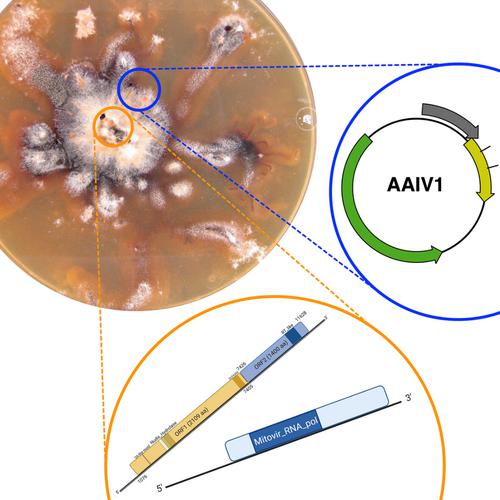当前位置:
X-MOL 学术
›
Environ. Microbiol.
›
论文详情
Our official English website, www.x-mol.net, welcomes your feedback! (Note: you will need to create a separate account there.)
Decoding the RNA virome of the tree parasite Armillaria provides new insights into the viral community of soil-borne fungi
Environmental Microbiology ( IF 5.1 ) Pub Date : 2024-02-13 , DOI: 10.1111/1462-2920.16583 Wajeeha Shamsi 1 , Renate Heinzelmann 1 , Sven Ulrich 1 , Hideki Kondo 2 , Carolina Cornejo 1
Environmental Microbiology ( IF 5.1 ) Pub Date : 2024-02-13 , DOI: 10.1111/1462-2920.16583 Wajeeha Shamsi 1 , Renate Heinzelmann 1 , Sven Ulrich 1 , Hideki Kondo 2 , Carolina Cornejo 1
Affiliation

|
The globally distributed basidiomycete genus Armillaria includes wood decomposers that can act as opportunistic parasites, causing deadly root rot on woody plants. To test whether RNA viruses are involved in this opportunistic behaviour, a large isolate collection of five Armillaria species collected over 40 years in Switzerland from trees, dead wood and soil was analysed. De novo assembly of RNA-Seq data revealed 21 viruses, 14 of which belong to putative new species. Two dsRNA viruses and an unclassified Tymovirales are formally described for the first time for Armillaria. One mitovirus occurred with a high prevalence of 71.1%, while all other viruses were much less prevalent (0.6%–16.9%). About half of all viruses were found only in one fungal species, others occurred in 2–6 fungal species. Co-infections of 2–7 viruses per isolate were not uncommon (34.9%), and most viruses persisted circulating within fungal populations for decades. Some viruses were related to viruses associated with other Armillaria species, supporting the hypothesis that virus transmission can occur between different fungal species. Although no specific correlation between viruses and the fungal trophic strategy was found, this study opens new insights into viral diversity hidden in the soil microbiome.
中文翻译:

解码树寄生虫蜜环菌的RNA病毒组为土传真菌病毒群落提供了新的见解
全球分布的担子菌属蜜环菌含有木材分解剂,可以作为机会性寄生虫,导致木本植物致命的根腐病。为了测试 RNA 病毒是否参与了这种机会主义行为,对瑞士 40 多年来从树木、枯木和土壤中收集的五种蜜环菌的大型分离集合进行了分析。 RNA-Seq 数据的从头组装揭示了 21 种病毒,其中 14 种属于假定的新物种。首次正式描述了蜜环菌的两种 dsRNA 病毒和一种未分类的鼓膜病毒目。一种线粒体病毒的流行率高达 71.1%,而所有其他病毒的流行率要低得多 (0.6%–16.9%)。大约一半的病毒仅在一种真菌物种中发现,其他病毒则在 2-6 种真菌物种中发现。每个分离株同时感染 2-7 个病毒的情况并不少见 (34.9%),并且大多数病毒在真菌种群中持续传播数十年。一些病毒与其他蜜环菌物种相关的病毒有关,支持病毒传播可以在不同真菌物种之间发生的假设。尽管没有发现病毒与真菌营养策略之间的具体相关性,但这项研究为隐藏在土壤微生物组中的病毒多样性提供了新的见解。
更新日期:2024-02-14
中文翻译:

解码树寄生虫蜜环菌的RNA病毒组为土传真菌病毒群落提供了新的见解
全球分布的担子菌属蜜环菌含有木材分解剂,可以作为机会性寄生虫,导致木本植物致命的根腐病。为了测试 RNA 病毒是否参与了这种机会主义行为,对瑞士 40 多年来从树木、枯木和土壤中收集的五种蜜环菌的大型分离集合进行了分析。 RNA-Seq 数据的从头组装揭示了 21 种病毒,其中 14 种属于假定的新物种。首次正式描述了蜜环菌的两种 dsRNA 病毒和一种未分类的鼓膜病毒目。一种线粒体病毒的流行率高达 71.1%,而所有其他病毒的流行率要低得多 (0.6%–16.9%)。大约一半的病毒仅在一种真菌物种中发现,其他病毒则在 2-6 种真菌物种中发现。每个分离株同时感染 2-7 个病毒的情况并不少见 (34.9%),并且大多数病毒在真菌种群中持续传播数十年。一些病毒与其他蜜环菌物种相关的病毒有关,支持病毒传播可以在不同真菌物种之间发生的假设。尽管没有发现病毒与真菌营养策略之间的具体相关性,但这项研究为隐藏在土壤微生物组中的病毒多样性提供了新的见解。



























 京公网安备 11010802027423号
京公网安备 11010802027423号